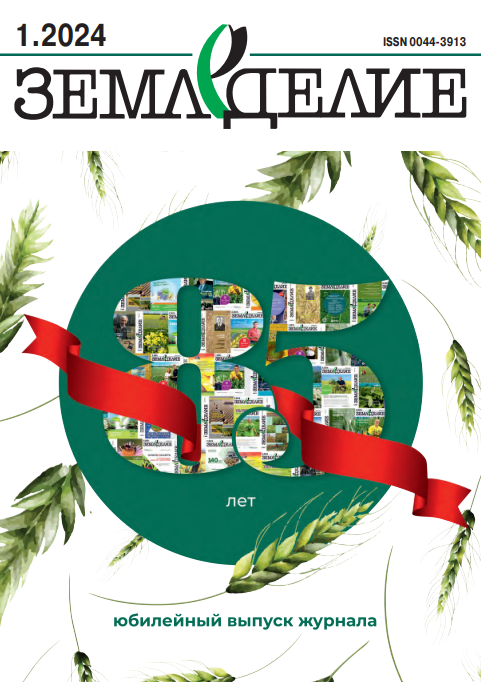Современное состояние освоения залежных земель в Республике Хакасия
Земледелие, 2016, № 6
УДК 631/635
Е.Я. ЧЕБОЧАКОВ1, кандидат сельскохозяйственных наук, старший научный сотрудник
Адрес электронной почты защищен от спам-ботов. Для просмотра адреса в вашем браузере должен быть включен Javascript.
Н.А. ГРАДОБОЕВА2, директор
В.Н. МУРТАЕВ1, магистрант
Н.В. СИРЕНЕВА2, зав. лабораторией
1Научно-исследовательский институт аграрных проблем Хакасии, ул. Садовая, 5, с. Зеленое, Усть- Абаканский р-н, Республика Хакасия, 655132, Российская Федерация
2Государственная станция агрохимической службы «Хакасская», ул. Хакасская, 25, Абакан, Республика Хакасия, 655017, Российская Федерация
В статье представлены результаты обобщения и анализа современного состояния освоения залежных земель в Республике Хакасия, расположенной на юге Средней Сибири. Динамику окультуривания 15-20-летней залежи, его влияние на продуктивность зерновых и зернобобовых культур и валовый сбор зерна анализировали до и в период распашки заброшенных земель. С целью увеличения производства зерна и кормов эти земли разрабатывали в 2006-2014 гг. преимущественно в более благоприятных агроэкологических условиях степной и лесостепной зон в северной и южной частях республики. Освоение залежных земель с широким применением разработанных приемов адаптивно-ландшафтных систем земледелия осуществляли на свободных территориях бывших совхозов «Целинный», «Борец», «Восток» Ширинского района. Анализ показывает, что обработка залежей началась в период улучшения социально-экономических условий, укрепления материально-технической базы хозяйств республики. В 2006 г. в Хакасии было освоено всего 3,9 тыс. га залежных земель, из них в степной зоне (Ширинский район) – 1,0 тыс., лесостепной (Орджони-кидзевский район) – 1,2 тыс. га. Наибольшие территории в республике окультурены в 2010-2012 гг. (18,0-27,8 тыс. га в год). К 2014 г. темпы их распашки значительно уменьшились (4,4 тыс. га). Освоение залежных земель и увеличение посевных площадей зерновых и зернобобовых культур в степной (Ширинский район) и лесостепной зоне (Орджоникидзевский) способствовали повышению валового сбора зерна в 2006-2013 гг., по сравнению с периодом до их освоения (2001-2005 гг.), в среднем в 1,4 раза.
Ключевые слова: земледелие, залежь, освоение, урожайность.
Для цитирования: Современное состояние освоения залежных земель в Республике Хакасия / Е.Я. Чебочаков, Н.А. Градобоева, В.Н. Муртаев, Н.В. Сиренева // Земледелие. 2016. № 6. С. 6-8.
Modern State of Fallow Land Developing in the Republic of Khakassia
E.Ya. Chebochakov1, N.A. Gradoboeva2, V.N. Murtaev1, N.V. Sireneva2
1Research Institute of Agricultural Problems of Khakassia, ul. Sadovaja, 5, s. Zelenoe, Ust’-Abakanskij r-n, Republic of Khakassia, 655132, Russian Federation
2State Agrochemical Service Station “Khakasskaya”, ul. Khakasskaya, 25, Abakan, Republic of Khakassia, 655017, Russian Federation
The article presents the results of the generalization and analysis of the current state of development of fallow lands in the Republic of Khakassia, located in the south of Central Siberia. The dynamics of development of 15-20 year fallow lands, its influence on productivity of grain and leguminous crops and gross harvest of grain was analyzed before and during plowing of fallow lands. In order to increase the production of grain and feed these lands were plowed in 2006-2014, mainly in more favorable agro-ecological conditions of the steppe and forest steppe zones in the northern and southern parts of the republic. The development of fallow lands with the extensive use of techniques of adaptive-landscape systems of agriculture was carried out on free lands of the former state farm “Tselinny”, “Borets”, “Vostok” of Shirinsky district. The analysis of the current state of development of fallow land shows that it began during the improvement of the socio-economic conditions, strengthening the material-technical base of the economy of the republic. In 2006, in Khakassia it was mastered only 3.9 thousand hectares of fallow land, of them in the steppe zone (Shirinsky district) – 1.0 thousand hectares, in the forest-steppe zone (Ordzhonikidzevsky district) – 1.2 thousand hectares. The largest area of fallow land in the republic was mastered in 2010-2012 (18 000-27 800 hectares per a year). By 2014 the rates of development decreased significantly (4 400 hectares). The development of fallow land and increase in acreage of grain and leguminous crops in the steppe zone (Shirinsky district) and forest-steppe one (Ordzhonikidzevsky district) contributed to the increase in the gross grain harvest in 2006-2013, compared with the period prior to their development (2001-2005) on the average 1.4 times.
Keywords: agriculture, fallow land, development, productivity.
Author Details: E.Ya. Chebochakov, Cand. Sc. (Agr.), senior research fellow (e-mail: Адрес электронной почты защищен от спам-ботов. Для просмотра адреса в вашем браузере должен быть включен Javascript.); N.A. Gradoboeva, director; V.N. Murtaev, graduate student; N.V. Sireneva, head of laboratory.
For citation: Chebochakov E.Ya., Gradoboeva N.A., Murtaev V.N., Sireneva N.V. Modern State of Fallow Land Developing in the Republic of Khakassia. Zemledelie. 2016. No 6. Pp. 6-8 (in Russ.).










